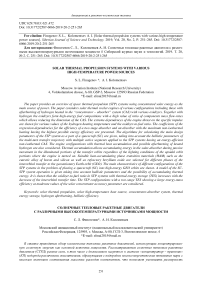Solar thermal propulsion systems with various high-temperature power sources
Автор: Finogenov S.L., Коlоmеntsеv А.I.
Журнал: Сибирский аэрокосмический журнал @vestnik-sibsau
Рубрика: Авиационная и ракетно-космическая техника
Статья в выпуске: 2 т.20, 2019 года.
Бесплатный доступ
The paper provides an overview of space thermal propulsion (STP) systems using concentrated solar energy as the main source of power. The paper considers solar thermal rocket engines of various configurations including those with afterburning of hydrogen heated in the “concentrator - absorber” system (CAS) with various oxidizers. Together with hydrogen the oxidizers form high-energy fuel compositions with a high value of ratio of components mass flow-rates which allows reducing the dimension of the CAS. The extreme dependences of the engine thrust on the specific impulse are shown for various values of the hydrogen heating temperature and the oxidizer-to-fuel ratio. The coefficients of the regression dependencies for the efficiency of a two-stage absorber and an absorber with the maximum non-isothermal heating having the highest possible energy efficiency are presented. The algorithms for calculating the main design parameters of the STP system as a part of a spacecraft (SC) are given, taking into account the ballistic parameters of the multi-turn transfer trajectory with multiple active segments applied to the STP systems having an energy-efficient non-isothermal CAS. The engine configurations with thermal heat accumulation and possible afterburning of heated hydrogen are also considered. Thermal accumulation allows accumulating energy in the solar-absorber during passive movement in the illuminated portions of the transfer orbits regardless of the lighting conditions of the apsidal orbit portions where the engine is turned on. Suitable heat-accumulating phase transition materials (HAM) such as the eutectic alloy of boron and silicon as well as refractory beryllium oxide are selected for different phases of the interorbital transfer to the geostationary Earth orbit (GEO). The main characteristics of different configurations of the STP systems in the problem of placing a spacecraft (SC) into high-energy GEO orbits are shown. A model of the SC- STP system operation is given taking into account ballistic parameters and the possibility of accumulating thermal energy. It is shown that the oxidizer-to-fuel ratio in STP systems with thermal energy storage (TES) increases with the decrease of the interorbital transfer time. The STP configurations with a two-stage TES showing a large energy-mass efficiency at moderate values of the solar concentrator accuracy parameter are considered.
Solar thermal propulsion, solar high-temperature heat source, concentrator-absorber system, thermal energy storage, hydrogen afterburning, ballistic efficiency
Короткий адрес: https://sciup.org/148321918
IDR: 148321918 | УДК: 629.78.03: | DOI: 10.31772/2587-6066-2019-20-2-251-265
Текст научной статьи Solar thermal propulsion systems with various high-temperature power sources
Introduction. Modern cosmonautics is characterized by the requirements to reduce the cost of placing SC into high working orbits by developing new energy-efficient interorbital transportation vehicles (ITV). Currently there is a steady global trend of increasing the mass and dimensional resources of a geostationary SC associated with the payback period of equipment. Therefore the development of highly efficient engines for ITV using alternative energy sources including solar energy is a highly topical problem.
Nowadays the levels of energy-mass perfection of traditional chemical rocket engines (liquid-propellant rocket engine (LPRE), solid-propellant rocket engine (SPRE)) are close to the limit in many respects, and engines with high specific impulses (nuclear rocket engine (NRE), electric jet engine EJE) have restrictions on the conditions of their use. One of the ways to increase the efficiency of thermal rocket engines is to increase the enthalpy of the fuel due to solar radiation as the most accessible source of energy in near-Earth space. STP systems can have a fairly simple configuration and better energy characteristics compared to chemical rocket engines.
Taking into account the high energy efficiency of direct conversion of solar radiation into the enthalpy of the working fluid it seems appropriate to study the energy possibilities of using STP systems with a high-temperature “concentrator-absorber” system (CAS).
The construction of a STP system requires the solution of complex scientific and technical problems, such as the development of an efficient high-temperature solar heat source (CAS and thermal accumulation capability) with the required energy-mass characteristics, optimal matching of its characteristics with SC parameters and ballistic parameters, ensuring engine orientation conditions including CAS tracking for the Sun, and a number of other tasks.
On the basis of the analysis of Russian and foreign works it has been shown that STP systems are considered primarily as systems including an isothermal CAS [1–6]. Particular solutions and approximation formulas that do not fully reflect the appropriate parameters of the CAS when matching engine characteristics with the main SC design parameters and ballistic parameters are given for non-isothermal solar absorbers [7]. Only oxygen is considered as an oxidizer for STP with afterburning. Graphite [5] is primarily considered as a heataccumulating material (HAM) for a STP system TES; the expedient characteristics of such an engine when it is integrated into the SC are not shown and the configurations with hydrogen afterburning with various oxidizers are not considered in the works with the proposed phase transition batteries [4; 8].
Simple hydrogen STP system. Let us consider the issues of creating a single-component hydrogen STP system with a CAS as a source of power. An STP system is considered as an engine for ITV from a low orbit to a high-energy one using the example of a geostationary Earth orbit (GEO). The mathematical formulation of the problem of placing a SC with a STP system to high working orbits is presented. The main relevant parameters of the STP system having the greatest impact on the efficiency criterion, that is, on the maximum mass of the payload (PL) MPL on the GEO are selected. It is shown that the relevant parameters include the tolerance of the Δα mirror concentrator (accuracy according to O. I. Kudrin [7]) and the heating temperature of the high-temperature part of the absorber To assumed to be equal to the hydrogen heating temperature TH2 . It is shown that they significantly depend on the interorbital transfer time, while the optimum temperature TH2 decreases with a decrease in the interorbital maneuver time, and the optimal parameter Aa increases. The optimal ratios of these parameters are revealed.
The CAS of three main configurations is considered: an isothermal one-stage system (OSS); a system with two stages of heating hydrogen in the absorber (TSS); a multistage system with non-uniform heating of hydrogen (MSS). Formally the problem statement is as follows:
T^= fix у = arg max MpL(v) Xq = fix ^gW,Z
Xk = fix
where у =< T o ; Aa > is the vector of the STP relevant parameters belonging to the set of alternative values V and Z and subject to optimization to ensure the maximum M PL at fixed values of the interorbital transfer time T 2 and phase coordinates of the initial and final orbits x 0 , xк .
The algorithm for selecting the relevant parameters for maximizing the mass of PL is considered in detail in [9]. The model takes into account the masses of SC and the engine according to known regression dependencies [10]. The accuracy of determining the PL mass is sufficient to make a decision on the choice of the preferred alternative among competing ITVs. The results of calculations on the example of various solar absorbers are shown in fig. 1–6
-
[11] as applied to the “Soyuz-2-1b” launch vehicle (LV). Here the conventional diameter of a mirror means its full dimensions (mid-mirror) collecting solar radiation into a focal light spot falling on a radial-type solar absorber.
If the efficiency of the isothermal (one-stage) absorber is determined simply by using the well-known formulas given in [7; 12], then for engineering calculations of the two-stage absorber efficiency the regression dependencies are proposed which are determined by the power series coefficients a i = f ( TH 2 ):
П = 2 a i -Aa i , i = 0... k . (2)
The values of the coefficients of the series depending on the heating temperature of hydrogen are presented in tab. 1.
STP systems with a non-isothermal CAS . The uneven heating of hydrogen in a non-isothermal absorber corresponds to a Gaussian diagram of the solar energy distribution in the focal light spot. For extremely uneven heating of the coolant in the absorber in the absence of radial heat transfer an assumption was made about the axisymmetric exponential distribution of the radiant flux in the focal light spot, which corresponds to the experimental aberrograms of real parabolic mirrors [7; 12–14].
Table 1
Coefficients for determining the two-stage absorber efficiency
|
T H2, К |
2000 |
2200 |
2500 |
2800 |
3000 |
3200 |
|
a 0 |
0.9160 |
0.8269 |
0.7877 |
0.7369 |
0.6891 |
0.6432 |
|
a 1 |
–0.3210 |
–0.9587 |
–0.0803 |
–0.3021 |
–0.4621 |
–0.2234 |
|
a 2 |
0.6896 |
–0.2633 |
–0.4654 |
0.0623 |
0.7874 |
1.1895 |
|
a 3 |
–0.0013 |
0.0362 |
0.2233 |
–0.0955 |
–0.7816 |
–2.7105 |
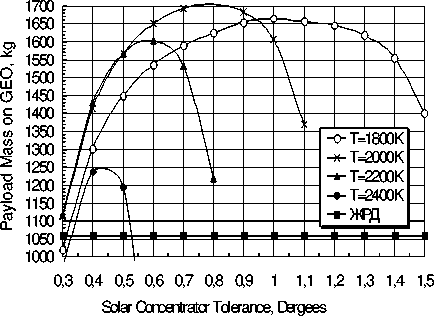
Fig. 1. The dependence of PL mass on the GEO on the concentrator tolerance for an isothermal absorber
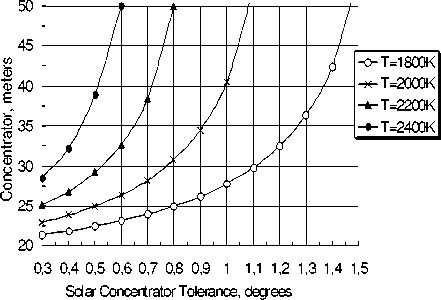
Fig. 2. The dependence of the mirror conventional diameter on the concentrator tolerance for an isothermal absorber
Рис. 1. Зависимость массы ПН на ГСО от параметра точности концентратора для равнотемпературного приемника
Рис. 2. Зависимость условного диаметра зеркала от параметра точности для равнотемпературного приемника
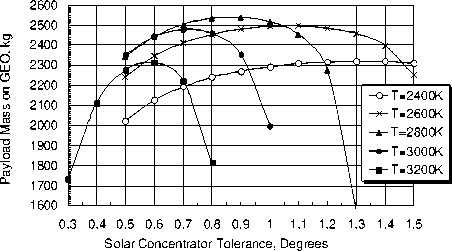
Fig. 3. The dependence of PL mass on the GEO on the concentrator tolerance for a two-stage absorber
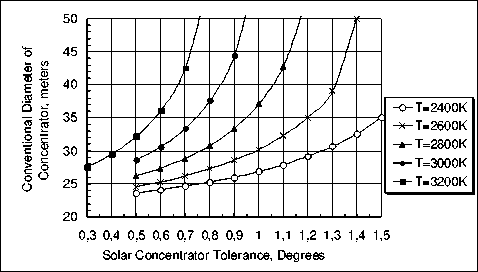
Fig. 4. The dependence of the mirror conventional diameter on the concentrator tolerance for a two-stage absorber
Рис. 3. Зависимость массы ПН на ГСО от параметра точности концентратора для двухступенчатого приемника
Рис. 4. Зависимость условного диаметра зеркала от параметра точности для двухступенчатого приемника
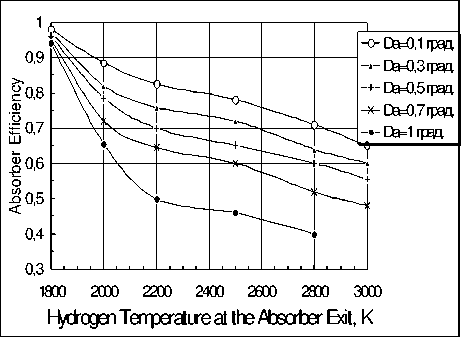
Fig. 5. The dependence of a two-stage absorber efficiency on exit temperature for different values of Aa (denoted as Da)
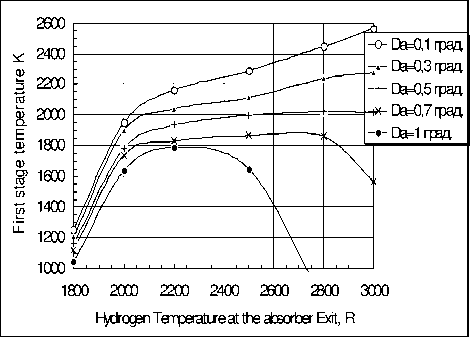
Fig. 6. The dependence of the absorber first stage temperature on final hydrogen temperature
Рис. 5. Зависимость КПД двухступенчатого приемника от температуры на выходе для различных значений Aa (обозначен как Da)
Рис. 6. Зависимость температуры первой ступени приемника от конечной температуры водорода
The temperature distribution over the radius of such an absorber can be described by a differential equation according to O. I. Kudrin [7]:
dT = 2 BT cond ГТ 4( r ) -
_ 2 4 a s T cond cos2 ©
- 1.2 r 2
r exp ,
I cos @ I
where T is the temperature of the absorber (assumed to be equal to the heating temperature of hydrogen); r is the relative radius of the absorber; a S is the effective absorption coefficient of solar radiation; B is a complex that takes into account the reciprocal self-radiation of the absorber, the optical parameters of the concentrator and the characteristics of solar radiation:
B _ seffGo 51П2(аo +Aa) 30nr sin2(2©)
Here s eff is the effective emissivity of the absorber; a o = 32’ is the apparent angular size of the Sun at the level of the Earth’s orbit; g o is the Stefan-Boltzmann constant; Q is the opening angle (aperture) of the mirror; Л = 1360 Вт/м2 is the surface power of solar radiation (solar constant) at the level of the Earth's orbit; n r is the reflection coefficient of the mirror surface of the concentrator.
The boundary conditions are written as T ( r = 1) = = T start = 20 К, that is, the temperature at the periphery of the absorber is equal to the temperature of the hydrogen evaporated in the tank. Then T ( r = 0) = T output is the exit
(final) temperature of heated hydrogen achieved in the central part of the absorber.
In equation (3) there is a “conventional temperature” T cond characterizing the ratio of the increase in the hydrogen temperature provided that all the concentrated solar energy is used to heat it. The ratio of the actual temperature of hydrogen at the outlet (minus the temperature of the hydrogen coming from the tank) to the conventional temperature determines the efficiency of the heating process. Conventional temperature depends on the area of the mirror concentrator and the mass flow rate of gas. The area of the mirror is determined, in its turn, by the efficiency of the CAS, which depends on temperature and its optical-geometric parameters including the parameter Δα . Therefore, the determination of the absorber efficiency and the final gas temperature is an iterative process requiring the specification of the initial conventional diameter of the concentrator and the flow characteristics of the engine.
Differential equation (3) in the general case has no analytical solution. In his work O. I. Kudrin [7] shows only two particular solutions restricted by a narrow application scope. In the present work equation (3) is solved numerically by Runge – Kutta – Fellberg method of order 4 and 5.
Comparing the approximate formulas for the efficiency of a non-isothermal CAS mentioned in the works of O. I. Kudrin [7] with the results of numerical integration one can note that the approximate formulas give a good result only for sufficiently accurate mirrors and not too high absorber temperatures. However, such values are not optimal from the standpoint of maximum PL mass when using stepped absorbers and they depend on the flight time. To determine the efficiency of the nonisothermal absorber one can propose more accurate dependences based on the results of the numerical integration of equation (3). Approximation formulas that allow simple determining the efficiency of a nonisothermal absorber depending on the tolerance at different hydrogen heating temperatures TH 2 are determined by the coefficients a i = f ( TH 2 ) of the power series (2) (tab. 2).
Fig. 7 presents the results of numerical simulation of the process of heating hydrogen to 3000 K. The dependences of the conventional temperature on the tolerance Δα are shown in fig. 8. It can be seen that the allowable value of the parameter Δα decreases with increasing the final hydrogen heating temperature. The excess of this parameter leads to a substantially non-linear increase in the conventional temperature and, as a result, to sharp decrease in the efficiency of the CAS accompanied by the increase in the size of the concentrator and its mass.
Fig. 9 presents the absorber efficiency values depending on the initially specified temperature refined during the iterative recalculation when integrating equation (3) for different values of the parameter Δα . The nature of these curves depends, among other things, on the conventional temperature indirectly determined by the parameter Δα . Under the condition of the STP system thrust constancy the increase in Δα leads to decrease in the hydrogen temperature at the outlet (fig. 10).
In tab. 3–5 [11] it is shown that the optimal hydrogen temperature and the optimal accuracy of the solar concentrator decrease, and the size of the solar concentrator increases with decrease in the time of the interorbital transfer.
At the same time, the requirements for the angular accuracy β of the dynamic tracking of the Sun position by the CAS which can be provided with modern technical means are reduced.
Fig. 11 shows a flowchart of the algorithm for optimal matching the STP characteristics with a non-isothermal absorber with the main design SC parameters (upper stage) and trajectory parameters that provide the maximum PL mass at a given interorbital transfer time [13].
STP systems with afterburning of heated hydrogen. Let us consider a STP system where hydrogen heated in the considered CAS is afterburnt by oxidizers which together with hydrogen form high-energy fuel compositions with a large stoichiometric mass flow rate of the components, which makes it possible to reduce the consumption of heated hydrogen for a given thrust and thereby reduce the required mirror size [15]. In addition to oxygen, fluorine (stoichiometric ratio with hydrogen K mo = 18.86) and hydrogen peroxide ( K mo = 12.09) are considered as oxidizers.
Such a STP system with afterburning can be considered as a liquid rocket engine with increased enthalpy of fuel. In contrast to a purely chemical engine in a STP system the thermal energy of heated hydrogen accounts for a significant proportion in the total enthalpy of fuel, therefore the heating value of the fuel affects the specific impulse to a lesser extent, and the choice of oxidizer can be carried out with better reason taking into account the value of the ratio of the components mass flow rates. In addition, the increased density of the fuel H 2 + F 2 or H 2 + H 2 O 2 facilitates placing the spacecraft into the original reference orbit.
Table 2
Coefficients for definition of non-isothermal absorber efficiency
|
T H2, К |
2500 |
2800 |
3000 |
3200 |
3500 |
3800 |
|
a 0 |
0.8304 |
0.8189 |
0.8149 |
0.8108 |
0.8047 |
0.7935 |
|
a 1 |
–0.0233 |
–0.0209 |
–0.0487 |
–0.0919 |
–0.1978 |
–0.3459 |
|
a 2 |
–0.0723 |
–0.1549 |
–0.1988 |
–0.2426 |
–0.2875 |
–0.3045 |
|
a 3 |
0.0024 |
0.0207 |
0.0311 |
0.0435 |
0.0573 |
0.0624 |
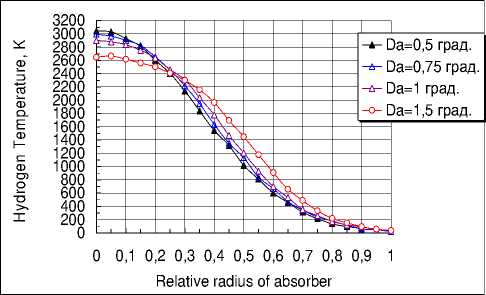
Fig. 7. The dependence of hydrogen heating temperature on the absorber relative radius
Рис. 7. Зависимость температуры нагрева водорода от относительного радиуса приемника
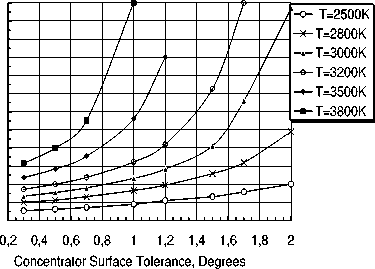
Fig. 8. The dependence of conventional temperature on concentrator tolerance
Рис. 8. Зависимость условной температуры от параметра точности концентратора
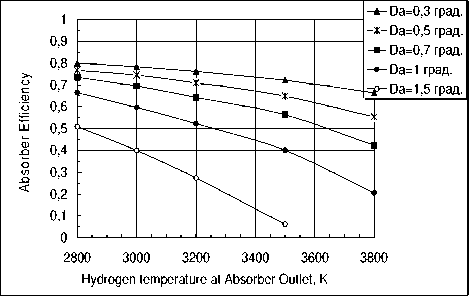
Fig. 9. The dependence of extremely non-isothermal absorber efficiency on the specified outlet temperature
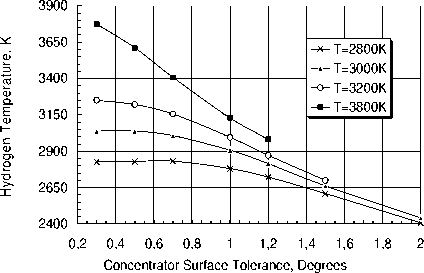
Fig. 10. The dependence of hydrogen temperature on concentrator tolerance for different specified initial heating temperature
Рис. 9. Зависимость КПД предельнонеравнотемпературного приемника от заданной температуры на выходе
Рис. 10. Зависимость температуры водорода от параметра точности для разных заданных начальных температур нагрева
Characteristics of spacecraft with a STP system for an isothermal absorber
Table 3
|
Mission Time, days |
Absorber Temperature, K |
Concentrator Tolerance Aa , deg. |
Conventional Mirror Diameter, meter |
Payload Mass on GEO, kg |
Angular accuracy в , degrees |
|
60 |
2200 |
0.64 ° |
20.8 |
1640 |
1.25 ° |
|
40 |
2100 |
0.7 ° |
23.7 |
1510 |
1.3 ° |
|
20 |
1900 |
1.0 ° |
33.0 |
1270 |
1.6 ° |
Table 4
|
Mission Time, days |
Absorber Temperature, K |
Concentrator Tolerance Aa , deg. |
Conventional Mirror Diameter, meter |
Payload Mass on GEO, kg |
Angular accuracy в , degrees |
|
60 |
3000 |
0.77 ° |
24.0 |
2180 |
1.39 ° |
|
40 |
2800 |
0.9 ° |
27.6 |
2050 |
1.53 ° |
|
20 |
2600 |
1.1 ° |
37.9 |
1810 |
1.74 ° |
Table 5
Characteristics of spacecraft with a STP system for non-isothermal absorber
|
Mission Time, days |
Absorber Temperature, K |
Concentrator Tolerance Aa , deg. |
Conventional Mirror Diameter, meter |
Payload Mass on GEO, kg |
Angular accuracy P , degrees |
|
60 |
3800 |
0.86 ° |
25.4 |
2600 |
1.48 ° |
|
40 |
3600 |
1.0 ° |
30.4 |
2480 |
1.64 ° |
|
20 |
3200 |
1.4 ° |
41.9 |
2230 |
2.0 ° |
Characteristics of spacecraft with a STP system for a two-stage absorber
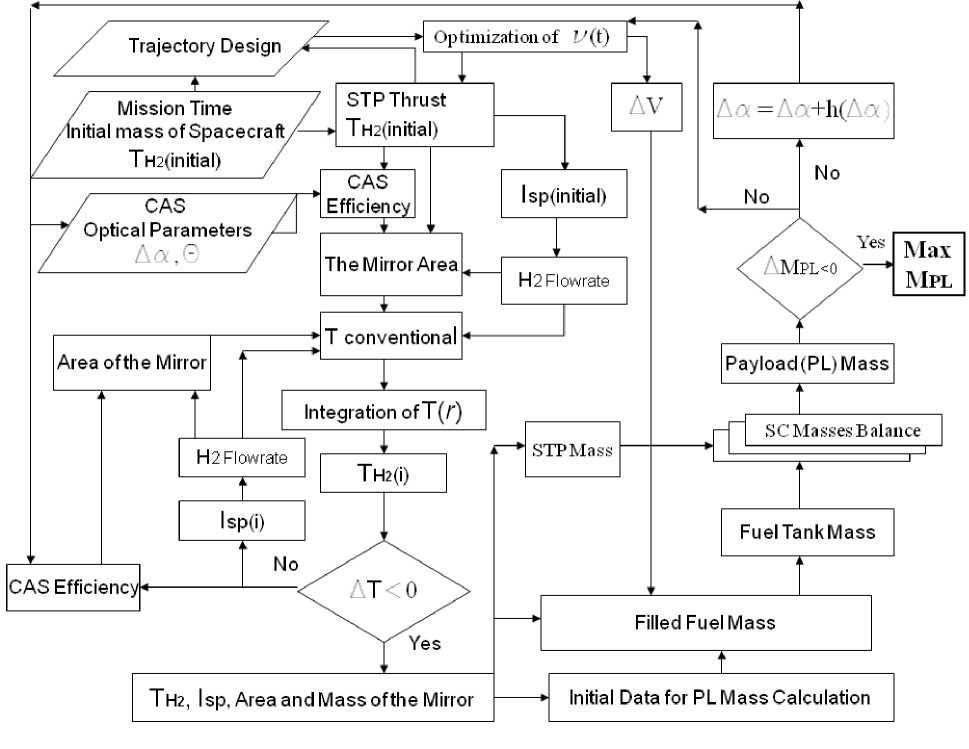
Fig. 11. The algorithm of optimal agreement of STP characteristics with SC
Рис. 11. Алгоритм оптимального согласования характеристик СТРД с КА
Opportunities of using oxygen and fluorine as oxidizers for a STP system as applied to the “Proton-M” launch vehicle are compared. As it can be seen from fig. 12, the mass efficiency of the space stage with the fluorine-hydrogen STP provides a gain in PL mass of more than 25 % with an oxidizer-to-fuel ratio a = 0.1 (Km = 0.19) in the case of an isothermal absorber, when appropriate values of a < 0.15 compared with the use of an oxygen-hydrogen booster with an oxygen-hydrogen liquid-propellant rocket engine KVD-1 when using light inflatable film mirrors. The use of an extremely nonisothermal absorber allows increasing the mass efficiency of the engine and significant expanding the range of a values at which a steady gain in the PL mass is maintained.
The graphs in fig. 13 show noticeably smaller paraboloid concentrator sizes in the case of a fluoridehydrogen STP compared to an oxygen-hydrogen one. The difference may be over 25 %.
The calculations show a lower mass efficiency of the STP use with H2 + H2O2 fuel in comparison with the use of fluorine or oxygen. The area a where the gain of STP with hydrogen peroxide over LPRE remains depends on the type of a CAS. The choice of the appropriate value of the oxidizer-to-fuel ratio at which the concentrator size is significantly reduced with an acceptable decrease in mass efficiency is very important. This takes into account the degree of temperature non-uniformity of the absorber and the type of the concentrator.
STP optimal thrust . On the basis of M. S. Konstantinov’s works [16; 17] it is shown that the values of the characteristic velocity for each pair ( j ; I у ) with optimized 3-segment many-revolution transfer can be used for further calculations for reactive accelerations j from 2.5 to 12.5 mm/s2 with I y from 600 to 900 s, which is typical for SC with STP.
However, in the case of STP with afterburning the same specific impulse can be provided by various combinations of the hydrogen heating temperature and the ratio of its mass flow rate to the flow rate of the oxidizer [18]. The energy-mass efficiency of a SC with such an engine can vary greatly. High-temperature heating (up to 2600–2800 K) is more advantageous with components mass flow-rate ratios in the range K m = 3.2–4 in order to achieve a moderate value of the specific impulse I у = 600 s. The nominal mirror diameter can be significantly (up to 40 %) reduced and the PL mass can be increased by 35 % for a low-temperature CAS (heating is not higher than 2000 K). In this case, the possible PL mass equal to 1950 kg is more than 1.8 times greater than that for the liquid-propellant booster of the “Fregat” type (the SC mass on the GEO is 1060 kg). Refined mass calculations of PL on the GEO were carried out for the optimized trajectory (fig. 14).
Taking into account the minimized (each time) values of the characteristic velocity it is possible to find the local maximum of the PL mass for each specific impulse value. For example, the specific impulse I у = 600 s corresponds to the optimal thrust of 100 N, and for I у = 900 s the optimal thrust is 70–80 N.
STP with TES . Let us consider a STP system with a CAS including TES which accumulates heat energy in the illuminated passive portions of each transfer orbit and gives it to hydrogen when the engine is turned on in the apsidal portions of the transfer orbits. This simplifies the task of selecting powered portions regardless of the light conditions and simplifies the desired guidance of the CAS to the Sun. The analysis [8; 19] showed that the feasible HAM should be searched between high-temperature HAM such as beryllium oxide and less refractory substances such as the eutectic 3BeO*2MgO. The eutectic boron alloy with silicon B*Si [8] belongs to such substances with an intermediate melting point and a high energy intensity.
A mathematical model of SC with STP operation has been developed to calculate and optimally match the engine characteristics with the “CA-TES” system, the main design SC parameters and orbital parameters [20] taking into account the thermophysical properties and transient processes in HAM [12; 21]. The mathematical model is designed as a software package and consists of five blocks (fig. 15).
The block (A) includes deterministic external factors. The ballistic block (Б) includes algorithms for solving the ballistic problem of determining the total flight time and the dynamic problem of determining the cost of the characteristic speed of the maneuver. Block (B) determines the main design SC parameters and calculation of the PL mass. Block (Г) includes calculation of energy-mass and geometric characteristics of STP with the “CA-TES” system and the possibility of hydrogen afterburning. Block (Д) includes coordination of the main design parameters of the STP and the SC and their optimization together with the parameters of motion control for identifying the extremum of the objective function of the operation (maximizing the PL mass) under the restriction of flight time.
The analysis of the operation of a SC with STP showed that the following parameters of the “CA-TES” system can be chosen as relevant ones at the stage of exploratory research: (a) the ratio of the energy intensity TES Q a to the area (or mass) of the mirror F з (or the ratio of the masses of the concentrator and TES MК / MТА )
and (b) the accuracy parameter of the mirror Aa . Formally the problem of choosing the optimal relevant parameters of STP with TES in a SC is as follows:
T ^ = fix
X 0 = fix
-
V = arg max M pl ( y )
VeT U x k = fix
T o = fix
where y =< Aa , M к / М ТА > is the vector of optimized relevant parameters of STP with TES, T 0 is the temperature of the absorber-accumulator taken to be equal to the melting temperature of the HAM under consideration, Mк / MТА is the ratio of masses of the concentrator and TES, х 0 , хк are the phase coordinates of the SC, T is the interorbital transfer time, У , U is the set of alternatives. The mathematical model of optimization of the main design parameters of the “SC-STP” technical system with the TES is shown in fig. 16.
The optimal mass ratios of the concentrator and TES are different for different HAMs, and they increase as their melting temperature increases. For example, for the eutectic 3BeO*2MgO the optimum Mк / MТА is 0.2, while for the B*Si alloy the optimum value Mк / MТА is 0.3–0.4, and for the refractory beryllium oxide Mк / MТА = 0.9 (fig. 17). The effect the concentrator tolerance on the PL mass is shown in fig. 18, whence it follows that there exist ranges of the parameter Aa optimal values depending on the melting point of particular HAM [19]. As the melting temperature of HAM increases, the optimum parameter Aa decreases (the optimum concentration of solar radiation increases), since greater accuracy dramatically augments the specific mass of the mirror reducing the PL mass due to the increase in engine mass, and the decrease in accuracy diminishes the efficiency of the CAS which requires larger area and mass of the mirror and also leads to a drop in the PL.
Reducing the time of the mission trip leads to a sharp decrease in the mass efficiency of the upper stage with the STP which is explained by significant increase in the mass of the CA and TES systems (fig. 19, 20).
STP with TES and hydrogen afterburning. Let us consider the effectiveness of the use of STP with TES and afterburning of hydrogen heated in TES with oxygen and fluorine. The problem has the following formalized formulation:
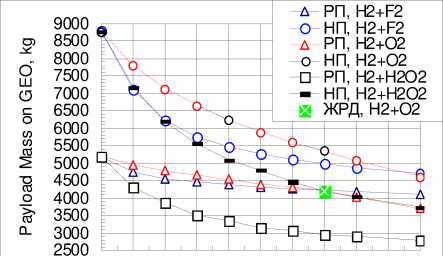
0 0,1 0,2 0,3 0,4 0,5 0,6 0,7 0,8 0,9 1
Oxidizer-to-Fuel Weight Ratio
Fig. 12. The dependence of PL mass on oxidizer-to-fuel ratio when using different oxidizers for hydrogen afterburning
Рис. 12. Зависимость массы ПН от коэффициента избытка окислителя при использовании различных окислителей для дожигания водорода
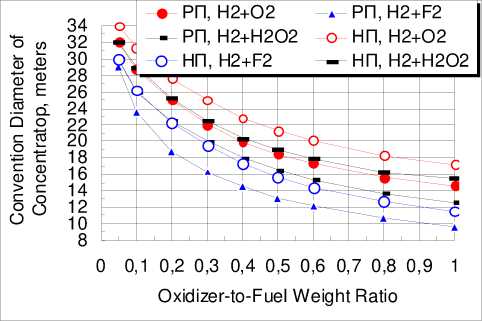
Fig. 13. The dependence of the convention concentrator diameter on oxidizer-to-fuel ratio when using different oxidizers for hydrogen afterburning
Рис. 13. Зависимость диаметра параболоидного концентратора от коэффициента избытка окислителя при использовании различных окислителей для дожигания водорода
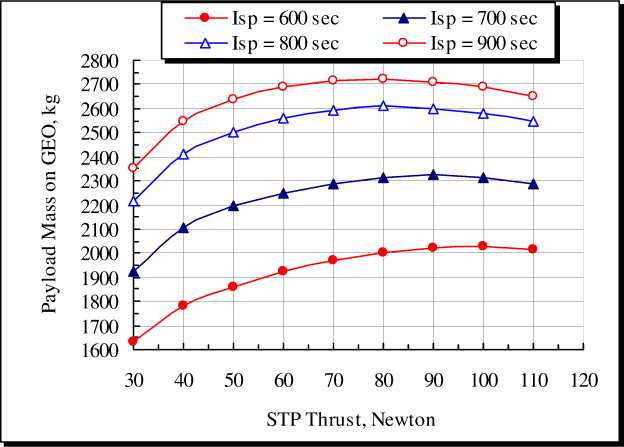
Fig. 14. The dependence of PL mass on the GEO on STP thrust: hydrogen temperature is 2800К, concentrator tolerance is Aa = 1 ° , time of placing on the GEO is 30 days
Рис. 14. Зависимость массы ПН на ГСО от тяги СТРД: температура водорода - 2800 К, параметр точности - Aa = 1 ° , время выведения на ГСО – 30 суток
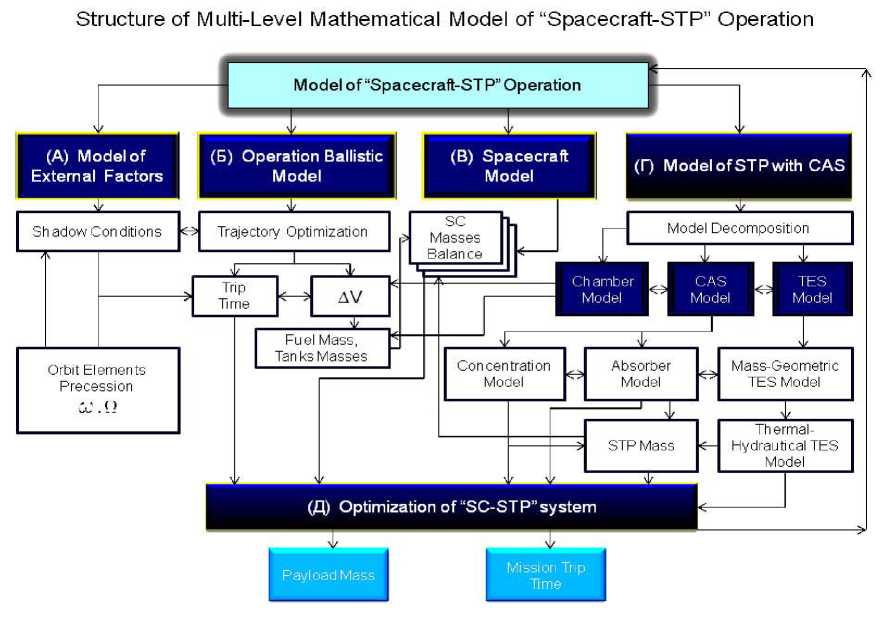
Fig. 15. The block-diagram of a mathematical model of a “SC-STP” technical system operation
Рис. 15. Блок-схема математической модели операции технической системы «КА-СТРД»
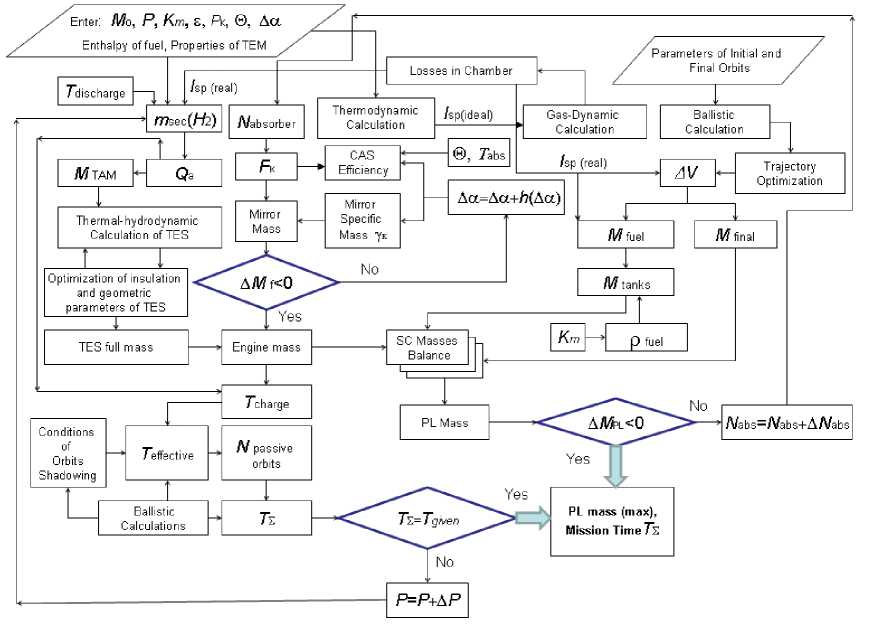
Fig. 16. The mathematical model of optimization of the main design parameters of the “SC-STP” technical system with TES
Рис. 16. Математическая модель оптимизации основных проектных параметров технической системы «КА-СТРД» с ТА
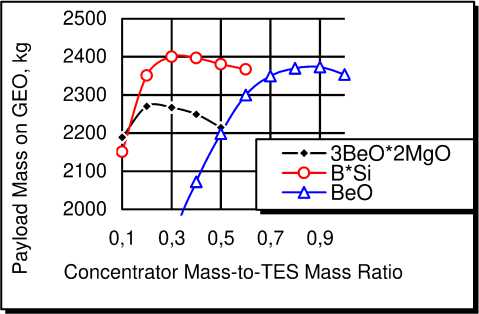
Fig. 17. The dependence of the PL mass on the mass ratio of the concentrator and TES for high-temperature HAM
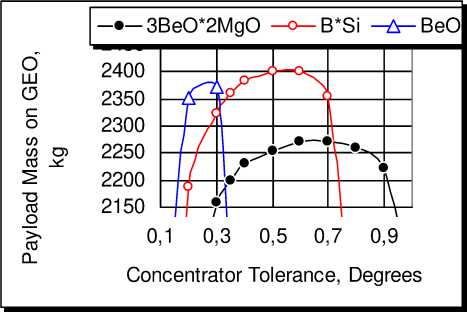
Fig.18. The dependence of the PL mass on the concentrator surface tolerance
Рис. 17. Зависимость массы ПН от соотношения масс концентратора и ТА для высокотемпературных ТАМ
Рис. 18. Зависимость массы ПН от параметра точности зеркала
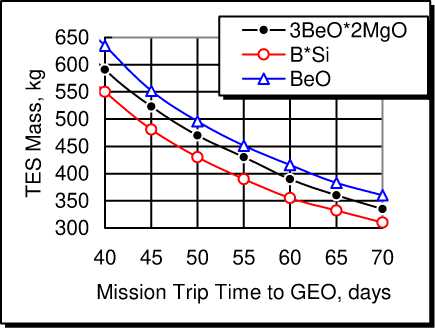
Fig. 19. The dependence of the TES mass on the time of placing into the GEO
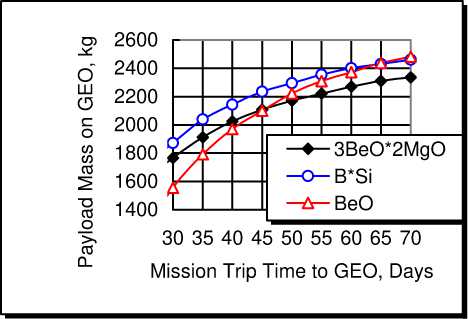
Fig. 20. The dependence of the PL mass on the time of placing into the GEO
Рис. 19. Зависимость массы ТА от времени выведения на ГСО
Рис. 20. Зависимость массы ПН от времени выведения на ГСО
The results of calculations according to the presented mathematical model (fig. 16) showed that when choosing an eutectic alloy of boron and silicon as HAM the appropriate value of the ratio Q a / F з is about 3.2 MJ/m2 with the optimum value of the accuracy parameter Аа = 0.5 ° and the selected rational value of the angular aperture of the mirror paraboloid 0 = 60 ° [20; 22]. This corresponds to the ratio of the energy intensity Q a to the mirror mass of about 2.8 MJ/kg which ensures the maximum of the operation objective function – the PL mass. The quantitative estimation of the allowable reduction in the dimension of the “CA-TES” system is clearly demonstrated in fig. 21, 22 in the coordinates { MPL ; Dк } (from right to left according to the indicated points - the increase of a from 0 to 1 in increments of 0.1).
It is shown that there are various ranges of reasonable values of a for the considered oxidizers corresponding to the largest PL (fig. 23). The results of similar calculations for the case of using beryllium oxide as HAM [2] are given as a comparative example in fig. 24.
Here the ratio Q а / N abs = 22–24 MJ/kW ( Q а / F к = = 7,5 MJ/m2) corresponds to the optimal interorbital transfer with the choice of the concentrator tolerance Аа = 0.25 ° . The results of the comparison show higher efficiency of the boron-silicon alloy with the same values of the oxidizer-to-fuel ratio over the entire considered time interval of the interorbital transfer. Compared to the promising combined ITVs that use high and low thrust engines for “raising” a SC on the GEO the gain in PL mass can be up to 450 kg with the same interorbital transfer time of 60 days.
STP with two-stage TES. In order to reduce the TES mass it may be advisable to use TES with two heating stages [8]. The efficiency of such a system is greater than that of an isothermal system; therefore in such a STP system it is possible to use, for example, refractory beryllium oxide BeO in a high-temperature stage with a significantly less accurate mirror having lower specific mass. Combinations of phase transition HAM with high latent heat of melting, for example, lithium hydride LiH in the low-temperature stage (melting point is 961 K, latent heat of melting is about 2540 kJ/kg* K) and BeO (melting point is 2804 K, latent heat of melting is
2840 kJ/kg*K) [3] are selected for construction of such an STP system. As it follows from the graphs in fig. 25–27, the PL mass on the GEO does not have an extremum within the ratio of the mirror mass to the TES mass 0.05–1 for the range Km = 0–1.6 and for the case K m = 0 it has a significant gain in PL mass on the GEO over other types of STP when the time of interorbital transfer is 60 days.
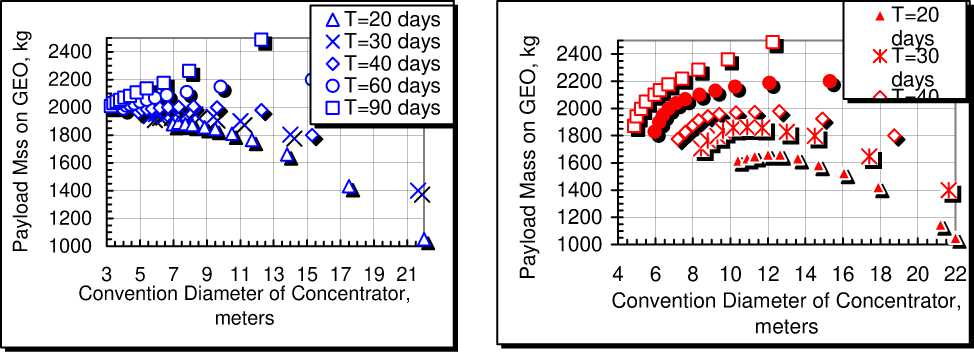
Fig. 21. The PL mass and the concentrator conventional diameter for different time of placing into the GEO while afterburning hydrogen with fluorine
Рис. 21. Масса ПН и условный диаметр концентратора для различного времени выведения на ГСО при дожигании водорода фтором
Fig. 22. The PL mass and the conventional diameter of the concentrator for different time of placing into the GEO while afterburning hydrogen with oxygen
Рис. 22. Масса ПН и условный диаметр концентратора для различного времени выведения на ГСО при дожигании водорода кислородом
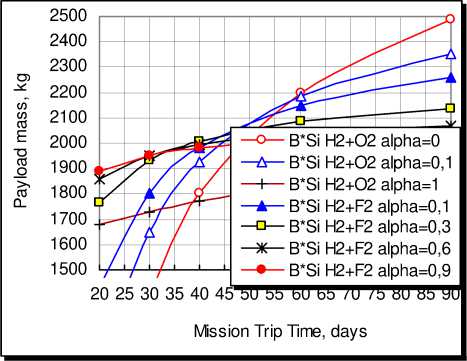
Fig. 23. The dependence of the PL mass on the time of placing into the GEO while afterburning hydrogen with oxygen and fluorine. HAM is the alloy B*Si
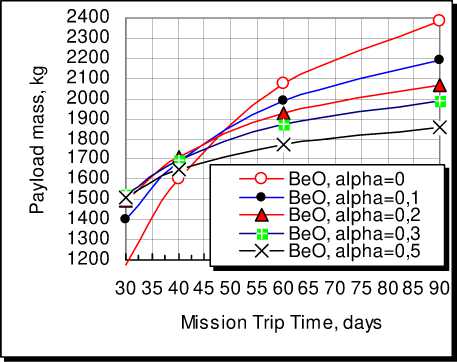
Fig. 24. The dependence of the PL mass on the time of placing into the GEO when using beryllium oxide as HAM and afterburning hydrogen with oxygen
Рис. 23. Зависимость массы ПН от времени выведения на ГСО при дожигании водорода кислородом и фтором. ТАМ – сплав B*Si
Рис. 24. Зависимость массы ПН от времени выведения на ГСО при использовании в качестве ТАМ оксида бериллия и дожигании водорода кислородом
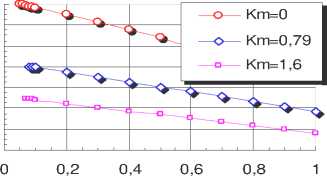
Concentrator-to-TES Mass Ratio
Fig. 25. The dependence of PL mass on the GEO on the ratio of the mirror mass to the TES mass for the values of Km = 0–1.6
Рис. 25. Зависимость массы ПН на ГСО от отношения массы зеркала к массе ТА для значений Km = 0–1,6
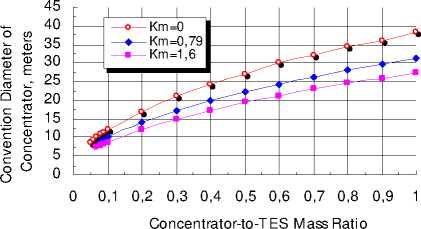
Fig. 26. The dependence of the concentrator conventional diameter on the ratio of the mirror mass to the TES mass for the values of Km = 0–1.6
Рис. 26. Зависимость условного диаметра концентратора от отношения массы зеркала к массе ТА для значений Km = 0–1,6
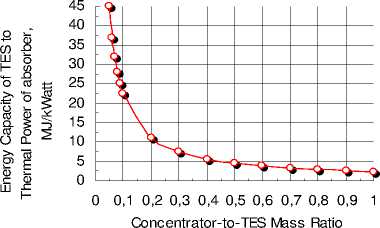
Fig. 27. The dependence of the ratio of TES energy intensity to the absorber thermal power on the ratio of the mirror mass to the TES mass
Рис. 27. Зависимость отношения энергоемкости ТА к тепловой мощности приемника от отношения массы зеркала к массе ТА
Conclusion. Rocket engines of configurations using solar energy in the CA system are considered. Numerical solutions are obtained for the problem of temperature distribution over the radius of the extremely nonisothermal absorber which made it possible to compile refined regression dependencies to determine its efficiency. The authors also obtained regression dependences for determining the efficiency of a two-stage absorber convenient for engineering calculations. The possibilities of improving the engine performance while using such absorbers to improve the flight efficiency of the SC are determined. Techniques for optimal matching the STP characteristics with various types of CAS and the main design SC parameters and ballistic parameters in the problem of interorbital transfer to high working orbits using the example of a GEO for different homing time have been developed. The dependences of the optimal temperature of hydrogen heating in the CAS on the time of SC placing into the GEO are revealed. It is shown that the optimal temperature of hydrogen and the optimal accuracy of the solar concentrator decrease, and the size of the solar concentrator increases with the reduction of the multi-turn interorbital transfer time.
Besides oxygen, fluorine and hydrogen peroxide are also proposed to be used as expedient oxidizers. Together with hydrogen they form high-energy fuel compositions with a large stoichiometric ratio of components flow-rates as applied to the STP configuration with afterburning. It is shown that when afterburning with these oxidizers the dimension of the CAS can be significantly reduced. The authors present the analysis of the flight characteristics of the SC with STP with hydrogen afterburning, including those with heating in a stepped CAS. It is shown that there are extremal dependences of the STP thrust on the specific impulse.
The expedient combinations of the concentrator accuracy parameter and the ratio of the solar concentrator mass to the TES mass for the HAMs considered are shown. It is shown that the ratio of the mirror mass to the TES mass can be expressed by the ratios of the TES energy intensity to the thermal power of the absorber or to the concentrator diameter as determining the time of the interorbital transfer. The optimal values of these parameters providing the maximum possible PL mass are given. The problems of optimal coordination of the characteristics of the STP with TES and the main design SC parameters and ballistic parameters in the transfer to high working orbits are posed and solved using the example of the GEO for different transfer time.
Mathematical models and software algorithms have been developed for the operation of the “STP with TES – SC” technical system and the optimization of its main design parameters. The expedient values of the concentrator tolerance and the ratio of the TES energy intensity to the absorber thermal power or the concentrator diameter when afterburning the heated in TES hydrogen with oxygen or fluorine were selected as a result of the calculation using the proposed model. The problems of optimal coordination of the characteristics of STP with TES and afterburning hydrogen with various oxidizers together with the main design parameters of the spacecraft and ballistic parameters in the transfer to high working orbits have been posed and solved. It is shown that the expedient values of the oxidizer-to-fuel ratio for the considered variants of STP with TES increase with decreasing time of the interorbital transfer.
Mass-geometric and energetic parameters of STP with a two-stage system “CA-TES” are considered. They show the possibility of using high-temperature TES such as beryllium oxide to provide a high specific impulse at moderate values of the solar concentrator tolerance. In this case the PL mass can be significantly increased compared with other types of STP at acceptable solar concentrator tolerance.
Список литературы Solar thermal propulsion systems with various high-temperature power sources
- Wassom S. R., Lester D. M., Farmer G., Holmes M. Solar Thermal Propulsion IHPRPT Demonstration Program Status // 37th Joint Propulsion Conference and Exhibit. Salt Lake City, UT, USA (July 08-11, 2001). AIAA Paper. 2001. № 2001-3735.
- Финогенов С. Л., Коломенцев А. И. Солнечный тепловой ракетный двигатель с оксид-бериллиевым фазопереходным тепловым аккумулятором и дожиганием водорода // Вестник Московского авиационного института. 2018. Т. 25, № 3. С. 107-115.
- Finogenov S. L, Kudrin O. I., Nikolenko V. V. Solar Thermal Propulsion with High-Efficient "Absorber-Thermal Storage" System // IAF Paper 1997, No S.06.05. 48th International Astronautical Congress (October 6-10, 1997). Turin, Italy.
- Gilpin M. R, Scharfe D. B., Young M. P., Webb R. Experimental Investigation of Latent Heat Thermal Energy Storage for Bi-Modal Solar Thermal Propulsion // 12th International Energy Conversion Engineering Conference. Cleveland, OH, USA. July 28-30, 2014. AIAA Paper, 2014. № 2014-3832 [Электронный ресурс]. URL: https://arc.aiaa.org/doi/. DOI: 10.2514/6.2014-3832
- Koroteev A. S. et al. Kick Stages with Solar Heat Propulsion Systems for Increase of Middle-Class Soyuz Launchers Competitiveness // Proc. of the 6th International Symposium on Propulsion for Space Transportation: Propulsion for Space Transportation of the XXIst Century. Versailles, France. May 2002.

